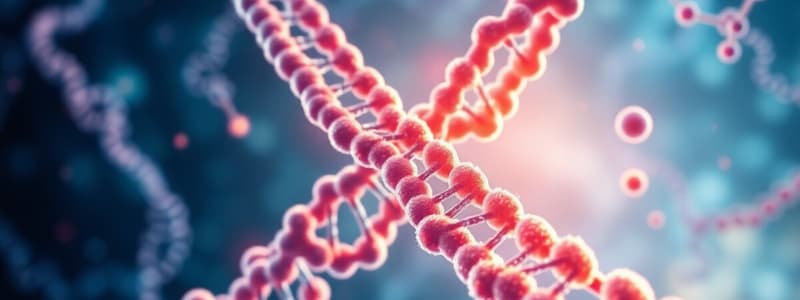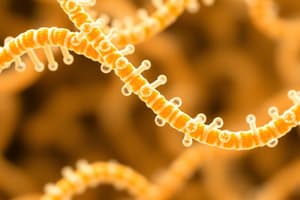Podcast
Questions and Answers
What is the primary function of nucleotides in biological systems?
What is the primary function of nucleotides in biological systems?
- Serving as building blocks of proteins
- Constituents of lipids
- Regulating temperature in cells
- Acting as a high energy source (correct)
Which bond connects the nucleotides in a polynucleotide chain?
Which bond connects the nucleotides in a polynucleotide chain?
- Phosphodiester bond (correct)
- Hydrogen bond
- Peptide bond
- Ionic bond
What are the components of a nucleotide?
What are the components of a nucleotide?
- Nitrogen base, pentose sugar, phosphate group (correct)
- Pentose sugar, amino acid, phosphate group
- Fatty acid, nitrogen base, carbohydrate
- Nitrogen base, amino acid, sugar
What is the role of phosphodiester bonds in nucleic acids?
What is the role of phosphodiester bonds in nucleic acids?
Which of the following is a pyrimidine nucleotide?
Which of the following is a pyrimidine nucleotide?
Which of these statements is true regarding the polarity of polynucleotides?
Which of these statements is true regarding the polarity of polynucleotides?
What are synthetic nucleotide analogues used for?
What are synthetic nucleotide analogues used for?
Which component of nucleotides can be classified as a purine base?
Which component of nucleotides can be classified as a purine base?
What are the two main types of nucleic acids?
What are the two main types of nucleic acids?
Which of the following correctly describes the composition of a nucleotide?
Which of the following correctly describes the composition of a nucleotide?
Which of the following nitrogenous bases is classified as a purine?
Which of the following nitrogenous bases is classified as a purine?
What is the role of a phosphate group in a nucleotide?
What is the role of a phosphate group in a nucleotide?
Which sugar is found in ribonucleic acid (RNA)?
Which sugar is found in ribonucleic acid (RNA)?
Which nitrogenous base is not a constituent of DNA?
Which nitrogenous base is not a constituent of DNA?
What bond connects the nitrogenous base to the pentose sugar in nucleotides?
What bond connects the nitrogenous base to the pentose sugar in nucleotides?
Which of the following statements about nucleosides is true?
Which of the following statements about nucleosides is true?
Flashcards are hidden until you start studying
Study Notes
Nucleic Acids
- Nucleic acids are polymers composed of nucleotides linked by phosphodiester bonds.
- They are responsible for storing and expressing genetic information.
- Two types of nucleic acids exist: ribonucleic acid (RNA) and deoxyribonucleic acid (DNA).
Nucleotides & Nucleosides
- Nucleotides are composed of a nitrogenous base, a pentose sugar, and a phosphate group.
- Nucleosides are composed of a nitrogenous base and a pentose sugar.
- A nucleotide is essentially a nucleoside with a phosphate group added.
Nitrogenous Bases
- Two families of nitrogenous bases exist: purine and pyrimidine.
- Purines include adenine (A) and guanine (G).
- Pyrimidines include cytosine (C), thymine (T), and uracil (U).
Pentose Sugar
- Two types of pentose sugars exist: ribose and deoxyribose.
- Ribose is present in ribonucleic acid (RNA).
- Deoxyribose is present in deoxyribonucleic acid (DNA) and differs from ribose by lacking an oxygen atom at carbon 2.
Phosphate
- Phosphate is derived from phosphoric acid (H3PO4) and attaches to carbon 5 of the ribose sugar by an ester bond.
Nucleotides and Nucleosides: Nomenclature and Structure
- In nucleotides and nucleosides, the nitrogenous base is linked to carbon 1 of the sugar by an N-glycosidic bond.
- Nucleotide Structure: Nitrogenous Base + Pentose Sugar + Phosphate Group
- Nucleoside Structure: Nitrogenous Base + Pentose Sugar
- Nucleotides are often named after their nucleoside with the addition of “monophosphate” (e.g., Adenosine monophosphate (AMP)).
- Deoxy-nucleotides are denoted with a "d" prefix (e.g., dAMP for deoxyadenosine monophosphate).
Importance of Nucleotides and Nucleosides
- Building blocks of Nucleic Acids: Form the basic structure of DNA and RNA.
- High Energy Source: ATP (adenosine triphosphate) is a primary energy carrier in cells.
- Coenzyme Components: Nucleotides are part of coenzymes like FAD (flavin adenine dinucleotide) and NAD (nicotinamide adenine dinucleotide).
- Regulatory Function: Cyclic nucleotides like cAMP (cyclic adenosine monophosphate) and cGMP (cyclic guanosine monophosphate) act as signaling molecules.
- Chemotherapeutic Drugs: Synthetic nucleotide analogues are used to target specific metabolic pathways in cancer treatment.
- Metabolic Precursors: Pyrimidines are precursors for important metabolic intermediates like UDP-glucose and CDP-choline.
Polymerization of Nucleotides
- Nucleotides within a nucleic acid are linked by 3' → 5' phosphodiester bonds.
- This linkage involves the phosphate group of one nucleotide attaching to the 3' hydroxyl group of the sugar in the next nucleotide.
- Nucleases are enzymes that hydrolyze phosphodiester bonds.
- Each polynucleotide has a 3' end (with a free hydroxyl group) and a 5' end (with a free phosphate group).
Studying That Suits You
Use AI to generate personalized quizzes and flashcards to suit your learning preferences.




